Knob-and-tube wiring
Knob-and-tube wiring (sometimes abbreviated K&T) is an early standardized method of electrical wiring in buildings, in common use in North America from about 1880 to the 1930s.[1][2] It consisted of single-insulated copper conductors run within wall or ceiling cavities, passing through joist and stud drill-holes via protective porcelain insulating tubes, and supported along their length on nailed-down porcelain knob insulators. Where conductors entered a wiring device such as a lamp or switch, or were pulled into a wall, they were protected by flexible cloth insulating sleeving called loom. The first insulation was asphalt-saturated cotton cloth, then rubber became common. Wire splices in such installations were twisted together for good mechanical strength, then soldered and wrapped with rubber insulating tape and friction tape (asphalt saturated cloth), or made inside metal junction boxes.

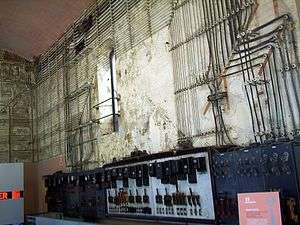
| Relevant topics on |
| Electrical installations |
|---|
| Wiring practice by region or country |
| Regulation of electrical installations |
| Cabling and accessories |
| Switching and protection devices |
Knob and tube wiring was eventually displaced from interior wiring systems because of the high cost of installation compared with use of power cables, which combined both power conductors of a circuit in one run (and which later included grounding conductors).
At present, new knob and tube installations are permitted in the U.S. only in a few very specific situations listed in the National Electrical Code, such as certain industrial and agricultural environments.
Elements
Ceramic knobs were cylindrical and generally nailed directly into the wall studs or floor joists. Most had a circular groove running around their circumference, although some were constructed in two pieces with pass-through grooves on each side of the nail in the middle. A leather washer often cushioned the ceramic, to reduce breakage during installation.
By wrapping electrical wires around the knob, and securing them with tie wires, the knob could be used to securely and permanently anchor the wire. The knobs separated the wire from potentially combustible framework, facilitated changes in direction, and ensured that wires were not subject to excessive tension. Because the wires were suspended in air, they could dissipate heat well.
Ceramic tubes were inserted into holes bored in wall studs or floor joists, and the wires were directed through them. This kept the wires from coming into contact with the wood framing members and from being compressed by the wood as the house settled. Ceramic tubes were sometimes also used when wires crossed over each other, for protection in case the upper wire were to break and fall on the lower conductor.
Ceramic cleats, which were block-shaped pieces, served a purpose similar to that of the knobs. Not all knob and tube installations utilized cleats.
Ceramic bushings protected each wire entering a metal device box, when such an enclosure was used.
Loom, a woven flexible insulating sleeve, was slipped over insulated wire to provide additional protection whenever a wire passed over or under another wire, when a wire entered a metal device enclosure, and in other situations prescribed by code.
Other ceramic pieces would typically be used as a junction point between the wiring system proper, and the more flexible cloth-clad wiring found in light fixtures or other permanent, hard-wired devices. When a generic power outlet was desired, the wiring could run directly into the junction box through a tube of protective loom and a ceramic bushing.
Wiring devices such as light switches, receptacle outlets, and lamp sockets were either surface-mounted, suspended, or flush-mounted within walls and ceilings. Only in the last case were metal boxes always used to enclose the wiring and device.
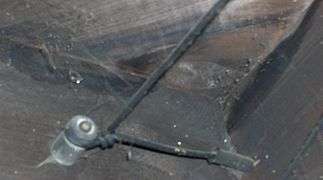 Knob supporting a wire change in direction.
Knob supporting a wire change in direction. Knob supporting a splice
Knob supporting a splice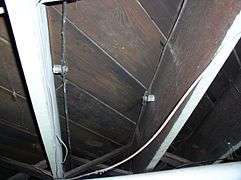 Knobs supporting long runs of wire
Knobs supporting long runs of wire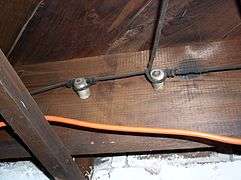 Knobs serving multiple functions
Knobs serving multiple functions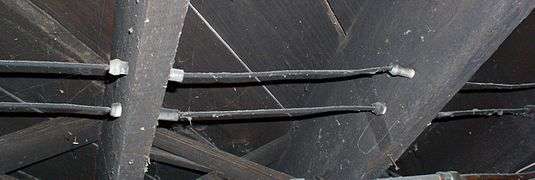 Ceramic tubes protecting wires passing through ceiling joists.
Ceramic tubes protecting wires passing through ceiling joists. Ceramic junction for suspended light socket. Note deteriorated cloth insulation.
Ceramic junction for suspended light socket. Note deteriorated cloth insulation.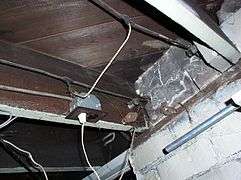 Splice with more modern power outlet, a probable code violation as seen here.
Splice with more modern power outlet, a probable code violation as seen here. Wiring running through tubes, and turning a corner supported by a knob. Notice the direct splice with more modern (1950s-era) non-metallic sheathed cable. This type of connection is forbidden by the National Electrical Code, and a junction box should have been used.
Wiring running through tubes, and turning a corner supported by a knob. Notice the direct splice with more modern (1950s-era) non-metallic sheathed cable. This type of connection is forbidden by the National Electrical Code, and a junction box should have been used.
Unusual wiring layouts
In many older K&T installations, the supply and return wires were routed separately from each other, rather than being located parallel to and near each other. This direct routing method has the advantage of reduced cost by allowing use of the shortest possible lengths of wire, but the major disadvantage is that a detailed building wiring diagram is needed for other electricians to understand multiple interwoven circuits, especially if the wiring is not fully visible throughout its length. By contrast, modern electrical codes now require that all residential wiring connections be made only inside protective enclosures, such as junction boxes, and that all connections must remain accessible for inspection, troubleshooting, repair, or modification.
Under the US electrical code, Carter system wiring layouts have now been banned, even for permissible new installations of K&T wiring. However, electricians must be aware of this older system, which is still present in many existing older electrical installations.
Neutral fusing
Another practice that was common (or even required) in some older K&T designs was the installation of separate fuses in both the hot wire and the neutral (return) wire of an electrical circuit. The failure of a neutral fuse would cut off power flow through the affected circuit, but the hot conductor could still remain hot relative to ground, an unexpected and potentially hazardous situation. Because of the presence of a neutral fuse, and in the event that it blew, the neutral conductor could not be relied on to remain near ground potential; and, in fact, could be at full line potential (via transmission of voltage through a switched-on light bulb, for example).
Modern electrical codes generally do not require a neutral fuse. Instead, they explicitly forbid configurations that might break continuity of the neutral conductor, unless all associated hot conductors are also simultaneously disconnected (for example, with ganged or "tied" circuit breakers).
Advantages
In the early 1900s, K&T wiring was less expensive to install than other wiring methods. For several decades, electricians could choose between K&T wiring, conduit, armored cable, and metal junction boxes. The conduit methods were known to be of better quality, but cost significantly more than K&T.[2] In 1909, flexible armored cable cost about twice as much as K&T, and conduit cost about three times the price of K&T.[3] Knob and tube wiring persisted since it allowed owners to wire a building for electricity at lower cost.
Modern wiring methods assume two or more load-carrying conductors will lie very near each other, as for instance in standard NM-2 cable. When installed correctly, the K&T wires are held away from the structural materials by ceramic insulators.
K&T wiring was commonly insulated with cotton cloth and soft rubber, in addition to the porcelain standoffs. Although the actual wire covering may have degraded over the decades, the porcelain standoffs have a nearly unlimited lifespan and will keep any bare wires safely insulated. Today, porcelain standoffs are still commonly used with bare-wire electric fencing for livestock, and such porcelain standoffs carry far higher voltage surges without risk of shorting to ground.
In short, K&T wiring that was installed correctly, and not damaged or incorrectly modified since then, is fairly safe when used within the original current-carrying limits, about ten amps per circuit.[4][5][6][7]
Disadvantages
Historically, wiring installation requirements were less demanding in the age of knob-and-tube wiring than today. Compared to modern electrical wiring standards, these are the main technical shortcomings of knob-and-tube wiring methods:
- never included a safety grounding conductor
- did not confine switching to the hot conductor (the so-called Carter system places electrical loads across the common terminals of a three-way switch pair)
- permitted the use of in-line splices in walls without a junction box (however, this downside is offset by the strong nature of the soldered and taped junctions used at the time).

Over time, the price of electrician labor grew faster than the cost of materials. This removed the price advantage of K&T methods, especially since they required time-consuming skillful soldering of in-line splices and junctions, and careful hand-wrapping of connections in layers of insulating tape.
Knob-and-tube wiring can be made with high current carrying capacity. However, most existing residential knob-and-tube installations, dating to before 1940, have fewer branch circuits than is desired today. While these installations were adequate for the electrical loads at the time of installation, modern households use a range and intensity of electrical equipment unforeseen at the time. Household power use increased dramatically following World War II, due to the wide availability of new electrical appliances and devices.
Modern home buyers often find that existing K&T systems lack the capacity for today's levels of power use. First-generation wiring systems became susceptible to abuse by homeowners who would replace blown fuses with fuses rated for higher current. This overfusing of the circuits subjects wiring to higher levels of current and risks heat damage or fire.
Knob-and-tube wiring may also be damaged by building renovations.[8] Its cloth and rubber insulation can dry out and turn brittle.[7] It may also be damaged by rodents and careless activities such as hanging objects from wiring running in accessible areas like basements.
Currently, the United States National Electrical Code forbids the use of loose, blown-in, or expanding foam insulation over K&T wiring.[9] This is because K&T is designed to let heat dissipate to the surrounding air. As a result, energy efficiency upgrades that involve insulating previously uninsulated walls usually also require replacement of the wiring in affected homes. However, California, Washington, Nebraska, and Oregon have modified the NEC to conditionally allow insulation around K&T. They did not find a single fire that was attributed to K&T, and permit insulation provided the home first passes inspection by an electrician.[10][11]
As existing K&T wiring gets older, insurance companies may deny coverage due to a perception of increased risk.[6] Several companies will not write new homeowners policies at all unless all K&T wiring is replaced, or an electrician certifies that the wiring is in good condition. Also, many institutional lenders are unwilling to finance a home with the relatively low-capacity service typical of K&T wiring, unless the electrical service is upgraded.[4][7][12] Partial upgrades, where low demand lighting circuits are left intact, may be acceptable to some insurers.
See also
References
- Croft, Terrell; Summers, Wilford, eds. (1987). American Electricans' Handbook (11 ed.). New York: McGraw Hill. ISBN 0-07-013932-6.
- Schneider, Norman Hugh (1916). "2-4". Wiring houses for the electric light; together with special references to low voltage battery systems. New York: Spon and Chamberlain.
- Knox, Charles E. (1909). Electric Wiring Instruction Paper. Chicago: American School of Correspondence.
- Krasner, Steve. "Knob-and-Tube Wiring: What's the Big Deal?". Only Connect: Electrical FAQ's. Retrieved 2011-03-19.
- Nick Gromicko, Rob London and Kenton Shepard. "Knob-and-Tube Wiring". Inspecting the World. Retrieved 2011-03-19.
- Carson Dunlop. "Knob and Tube Wiring & Home Owners' Insurance". Carson Dunlop Report. Retrieved 2011-03-19.
- KNTelectric. "Knob and Tube Wiring - an unbiased review". Archived from the original on 2011-12-02.
- Friedman, Daniel. "Electrical Knob & Tube Electrical Wiring Inspection, Evaluation, & Repair Suggestions". InspectAPedia. InspectAPedia.com. Retrieved 2011-03-19.
- William Kibbel III. "Ask the Home Inspector: Knob and Tube Wiring". Old House Web. Retrieved 2010-04-13.
- "Knob-and-Tube Wiring Hang-ups". Home Energy Magazine. Energy Auditor & Retrofitter, Inc. Retrieved 2010-04-13.
- "Letters: Knob and Tube Not a Fire Hazard". Home Energy Magazine. Energy Auditor & Retrofitter, Inc. Retrieved 2011-12-31.
- "Did you know that..." (PDF). Insurance coverage issues affecting older homes. Financial Services Commission of Ontario. Retrieved 2012-05-20.
Further reading
- Cauldwell, Rex (2009). Wiring a house (4th ed.). Newtown, CT: Taunton Press. ISBN 978-1600852619.
- Shapiro, David E. (2010). Old electrical wiring: evaluating, repairing, and upgrading dated systems (2nd ed.). New York: McGraw-Hill. ISBN 978-0071663571. — written for professional electricians and advanced property owners
- Shapiro, David E. (2001). Your old wiring. New York: McGraw-Hill. ISBN 978-0071357012. — written for home owners and do-it-yourselfers
External links
| Wikimedia Commons has media related to Knob and tube wiring. |